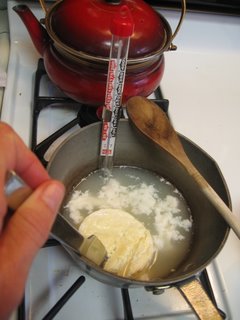








in other raw milk news,
i made cottage cheese:
one with raw whole milk, and
one with raw skim.
i put the two jars of raw milk in the oven with the light on (right next to the sourdough starter i'm still sweet-talking.. ),
and waited two days.
today i will cut the curds, drain off the whey, and wash the curds with filtered water.
then we'll have a taste test to see which we like best: whole milk cottage cheese, or skim. as yummy as whole milk products are, i can't imagine the skim would be tastier, but we'll see. .
alright, well. the results are in.
this was a positive experiment, but i really needed more milk to do it up right.
my main complaint was that the milk in the pan was so shallow that i had to babysit each batch intensively (i had to consult the Christmas Ale for support) to keep it at the recommended 110 degrees for 30 mins. i'd let it get up to temp (or a couple over) and then take it off the stove. . over and over. and it turns out that the skim was really the proper choice for cottage cheese (as my recipe further recommended). it curdled and firmed up in the expected amount of time. very pretty. the whole milk, on the other hand, was a creamy mess (gorgeous yellow cream, but all the same) that took forever (3 times as long as the skim.. ) to firm up. i washed the skim milk curds as per directions, but couldn't bare to wash away all that beautiful cream from the whole milk batch, so .. . after hours of draining it, i ended up simply mixing the two batches together for a small bowlful of creamy loveliness. it was more tangy than the kind you get at the store, with a luscious creamy sauce.
what i did:
heat each batch to 110 on the stove.
i cut the curds into relatively uniform pieces,
and stirred everyonce in a while to keep them from "matting".
once they became firm between my fingers, as opposed to their original custard-ish texture,
i drained off the whey,
and washed the curds (of the skim) in cold, filtered water.
then i left them in their cotton baggy to drain for a while.
the cookbook i consulted is _Home_Cheese_Making_, by Ricki Carroll, purportedly the american Guru of home cheese making, and a seminal agent in the recent american *craft cheese revival*.
one of the products of my natural chef education was learning about, and being directed to resources about: the whole body benefits of raw, grass-fed milk. pasteurized milk protects us from the ill effects of *industrialization*, not milk. cows that have the opportunity to live as they were created to live ~ browsing fields of grass ~ produce milk that is wholly good.
for more information on this, i highly recommend
www.realmilk.com
to learn more about Organic Pastures (the milk we use), you can visit their site at
http://www.organicpastures.com/index.html
photos, in blogger-random: incubating. can you tell which is whole milk and which is skim?
cutting the curd,
comparing the jars: one with a thick layer of yellow cream, the other with just a skim,
side-view,
the curds a-stewin',
draining the whey,
the jar of whey (from the skim),
the finished skim cottage cheese,
the whole curds, with their cream soup, draining.


2 comments:
weeeelll,...I can't help sticking my nose in just a little here to say (from my geeky vet-education place) that pasteurization protects us from diseases like brucellosis or tuberculosis and others that are zoonotic and can be passed to humans in the milk. It is true, though, that these diseases have been eradicated from the US for all intents and purposes.
I'd go for the grass fed pasteurized milk before I'd go for the silage fed unpasteurized is all I'm sayin.
oh, geez ~ for sure!!
i think knowing the source is essential with animal products. i appreciate your knowledge, Mz. Vet-rinary Person. ;)
i would always recommend pasteurization unless you knew for certain how the animals were raised, and that the folks who raise them care (which is often inherent in their practices. .). .
Post a Comment